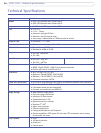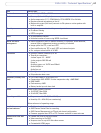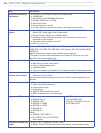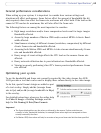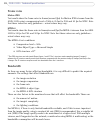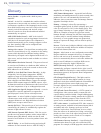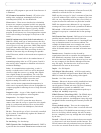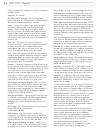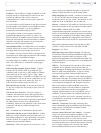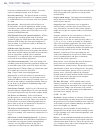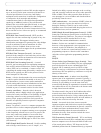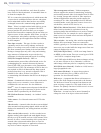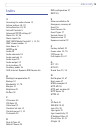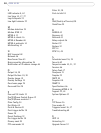
74
AXIS 233D - Glossary
software running on a computer, or it can be a standalone
hardware device.
Fixed iris - See Autoiris.
FTP (File Transfer Protocol) - FTP is an application
protocol that uses the TCP/IP protocols, used to exchange
files between computers/devices on networks.
Frame - A frame is a complete video image. In the 2:1
interlaced scanning format of the RS-170 and CCIR
formats, a frame is made up of two separate fields of
262.5 or 312.5 lines interlaced at 60 or 50 Hz to form a
complete frame, which appears at 30 or 25 Hz. In video
cameras with a progressive scan, each frame is scanned
line-by-line and not interlaced; most are also displayed at
30 and 25 Hz.
Frame rate - The frame rate used to describe the
frequency at which a video stream is updated is measured
in frames per second (fps). A higher frame rate is
advantageous when there is movement in the video
stream, as it maintains image quality throughout.
Gain - Gain is the amplification factor and the extent to
which an analog amplifier boosts the strength of a signal.
Amplification factors are usually expressed in terms of
power. The decibel (dB) is the most common way of
quantifying the gain of an amplifier.
Gateway - A gateway is a point in a network that acts as
an entry point to another network. In a corporate network
for example, a computer server acting as a gateway often
also acts as a proxy server and a firewall server. A
gateway is often associated with both a router, which
knows where to direct a given packet of data that arrives
at the gateway, and a switch, which furnishes the actual
path in and out of the gateway for a given packet.
GIF (Graphics Interchange Format) - GIF is one of the
most common file formats used for images in web pages.
There are two versions of the format, 87a and 89a.
Version 89a supports animations, i.e. a short sequence of
images within a single GIF file. A GIF89a can also be
specified for interlaced presentation.
GOV (Group Of VOPs) - A group of VOPs is the basic unit
of an MPEG-4 video stream. The GOV contains different
types and numbers of VOPs (I-VOPs, P-VOPs) as
determined by the GOV length and GOV structure. See
also VOP.
GOV length - The GOV length determines the number of
images (VOPs) in the GOV structure.
See also GOV and VOP.
GOV structure - The GOV structure describes the
composition of an MPEG-4 video stream, as regards the
type of images (I-VOPs or P-VOPs) included in the stream,
and their internal order. See also GOV and VOP.
HTML (Hypertext Markup Language) - HTML is the set
of “markup” symbols or codes inserted in a file intended
for display in web browser. The markup tells the browser
how to display the page's words and images for the user.
HTTP (Hypertext Transfer Protocol) - HTTP is the set of
rules for exchanging files (text, graphic images, sound,
video, and other multimedia files) on the web. The HTTP
protocol runs on top of the TCP/IP suite of protocols.
HTTPS (Hypertext Transfer Protocol over SSL) - HTTPS
is a protocol used by web browsers and servers to encrypt
and decrypt user page requests and the pages returned by
the server. The encrypted exchange of information is
governed by the use of an HTTPS certificate (issued by a
Certificate Authority), which guarantees the authenticity
of the server.
Hub - A (network) hub is used to connect multiple devices
to the network. The hub transmits all data to all devices
connected to it, whereas a switch will only transmit the
data to the device it is specifically intended for.
IEEE 802.11 - A family of standards for wireless LANs.
The 802.11a standard supports 1 or 2 Mbit/s transmission
on the 5 GHz band. IEEE 802.11b supports data rates up
to11 Mbit/s on the 2.4 GHz band, while 802.11g allows up
to 54 Mbit/s on the 2.4 GHz band.
Image compression - Image compression minimizes the
file size (in bytes) of an image. Two of the most common
compressed image formats are JPEG and GIF. See also
MPEG and Motion JPEG.
Interlacing - Interlaced video is video captured at 50
pictures (known as fields) per second, of which every 2
consecutive fields (at half height) are then combined into
1 frame. Interlacing was developed many years ago for
the analog TV world and is still used widely today. It
provides good results when viewing motion in standard
TV pictures, although there is always some degree of
distortion in the image.
To view interlaced video on e.g. a computer monitor, the
video must first be de-interlaced, to produce progressive
video, which consists of complete images, one after the
other, at 25 frames per second. See also Progressive scan.
IP (Internet Protocol) - The Internet Protocol is a method
transmitting data over a network. Data to be sent is
divided into individual and completely independent
“packets”. Each computer (or host) on the Internet has at
least one address that uniquely identifies it from all
others, and each data packet contains both the sender's
address and the receiver's address.
The Internet Protocol ensures that the data packets all
arrive at the intended address. As IP is a connectionless
protocol, which means that there is no established
connection between the communication end-points,
packets can be sent via different routes and do not need
to arrive at the destination in the correct order.
Once the data packets have arrived at the correct
destination, another protocol - Transmission Control
Protocol (TCP) - puts them in the right order.



